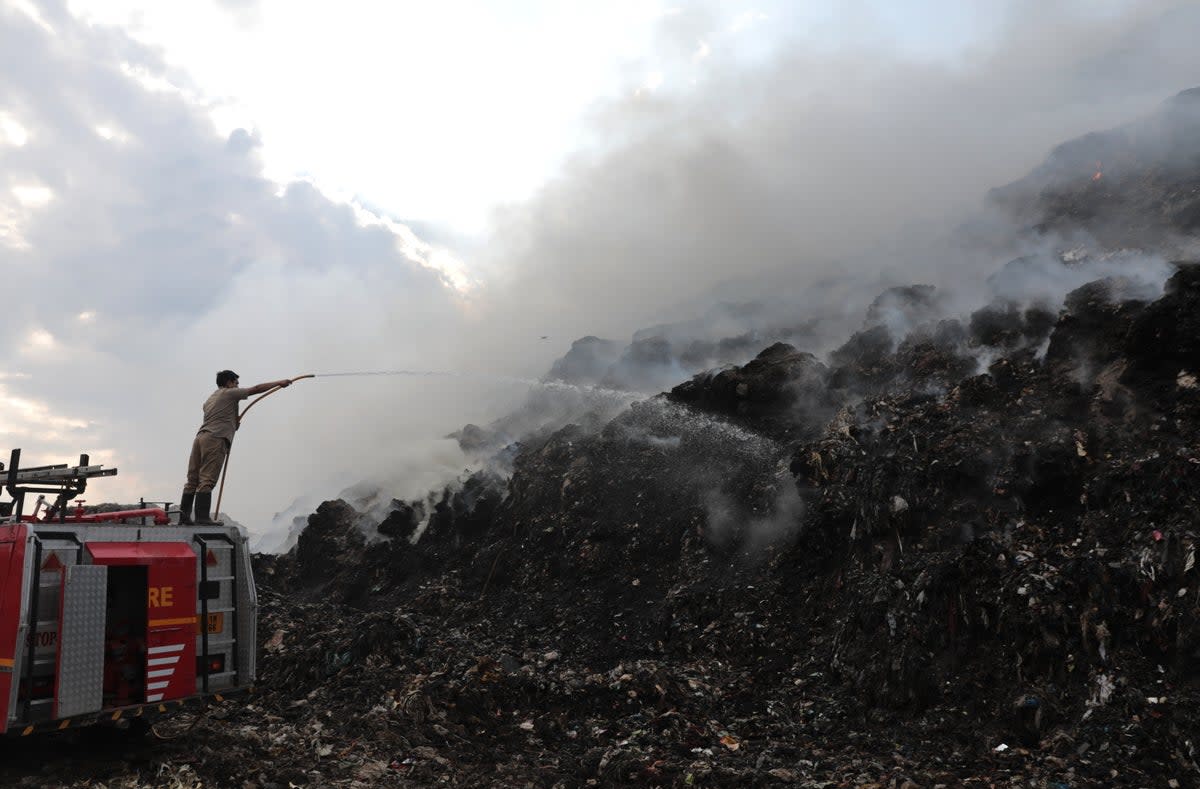Toxic smoke from burning garbage mountain blankets India’s capital

One of India’s largest rubbish mounds is on fire, continuing to burn after almost 24 hours and spewing toxic fumes into the air of a densely populated area on the outskirts of the capital Delhi.
The Ghazipur landfill, which takes up more than 40 football fields and rises to a height of 65m, caught fire on Sunday evening amid soaring temperatures in the region.
The fire was still burning on Monday and at least six fire tenders were on the spot trying to put it out, local officials said.

It is not uncommon for the landfill to catch fire that lasts days, especially during India’s rapidly intensifying heatwaves which make such methane-rich landfills highly combustible.
The landfill last caught a major fire during the deadly 2022 heatwave. In 2018, part of the mound had collapsed, killing two people.
A thick layer of toxic smoke has blanketed the area packed with residential and commercial buildings, with residents complaining of breathing issues.
“We are unable to keep our eyes open due to irritation and are experiencing difficulty breathing,” Ram Kumar, a resident of nearby Gharoli village, told NDTV news channel.
Just drove past a terrible fire engulfing the Ghazipur landfill! Such fire outbreaks are hard to contain and bring into focus the systemic failure of our waste management policies and practices. pic.twitter.com/Aq5JOPQjqO
— Jayant Singh (@jayantrld) April 21, 2024
#Video | Fire breaks out at Delhi's Ghazipur landfill site pic.twitter.com/GhnrYSbSia
— NDTV (@ndtv) April 21, 2024
Harjeet Singh, global engagement director of Fossil Fuel Non-Proliferation Treaty and a climate activist, who lives close to the landfill says the repeated fires on the site are a proof that “our cities are crumbling under the weight of their own waste”.
"The recent fire at the Ghazipur landfill in Delhi is a glaring testament to how our development model has gone disastrously wrong,” he told The Independent.
“This toxic 'mountain,' built from decades of unchecked urban waste, not only chokes our skies but also emits methane—a potent accelerator of climate change—into our atmosphere."
Inhaling toxic smoke from the landfill can cause severe health problems, experts said.
“Inhalation of smoke from landfill fires can cause immediate irritation to the respiratory tract, leading to symptoms such as coughing, wheezing, and difficulty breathing,” Dr Shivakumar K, a senior consultant pulmonologist at Birds Clinic, told The Indian Express.
Prime minister Narendra Modi’s Bharatiya Janata Party, which is in opposition in Delhi, slammed Arvind Kejriwal, the state’s leader currently jailed on corruption charges, for his administration’s “failure” to clean up the landfill.
“The Delhi government has failed,” said BJP spokesperson RP Singh. “They claimed to clear the landfill by December 2023. But they are corrupt and indulge in internal conflicts. They don’t care about Delhi.”
Meanwhile,
The landfill was opened in 1894 and reached its capacity in 2002. But it is still growing, with nearly 2,000 tons of garbage dumped daily, and is expected to grow taller than the Taj Mahal soon.
Indian cities generate 62 million tons of waste each year and current projections say this will increase to 165 million by 2030.
“We must confront the climate crisis by integrating sustainable waste management solutions into the fabric of urban planning,” Mr Singh says. “Only then can we hope to protect our planet and ensure justice for the communities most vulnerable to these man-made disasters.”


